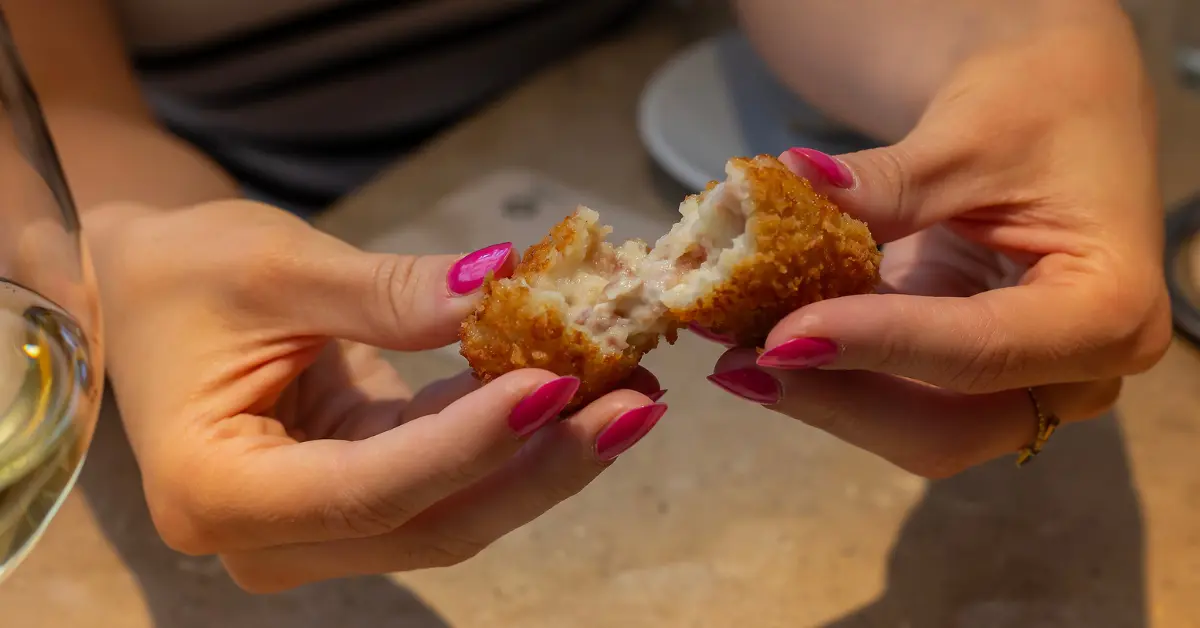Spain is a country rich in history, culture, and flavor. Spanish cuisine reflects its diverse regions, combining Mediterranean ingredients with unique cooking traditions. A typical day of eating in Spain follows a rhythm that may be different from other countries. Breakfast, or “desayuno,” is usually light, consisting of coffee, toast, or a pastry. Lunch, or “comida,” is the main meal of the day, often starting around 2 p.m., with multiple courses and followed by a siesta. Dinner, or “cena,” is typically served later in the evening, between 9 and 11 p.m., and is usually a lighter meal. Between these meals, Spaniards enjoy snacks or “tapas” to tide them over, often accompanied by drinks and socializing. Let’s dive into five must-try foods that showcase the heart and soul of Spanish cuisine and that just happen to be some of my favorites.
1. Tortilla de Patata (Spanish Omelette)
This iconic Spanish dish consists of eggs, potatoes, and sometimes onions, all slowly fried and folded into a thick, satisfying omelette. Simple but full of flavor, tortilla de patata can be enjoyed warm or cold, as a tapa or a meal in itself. Every region has its variation, with some preferring it runny inside, while others like it firm. There is even a heated debate if you should serve the tortilla with onion or without onion. It’s often served as a staple in bars, making it a must-try when exploring Spain.
2. Zamburiñas (Scallops)
Zamburiñas are small, flavorful scallops found along Spain’s northern coast, particularly in Galicia. They’re typically grilled or baked, often with a topping of garlic, parsley, and breadcrumbs. Their tender, sweet taste reflects the fresh ocean waters they come from. You’ll commonly find zamburiñas as part of a seafood platter or served as tapas in coastal regions, offering a taste of Spain’s rich maritime bounty.
3. Croquetas (Croquettes)
Croquetas are a beloved comfort food in Spain, made by deep-frying béchamel sauce mixed with ingredients like ham, chicken, or cod until they’re golden and crispy. Creamy inside and crunchy outside, they’re often served in bars and homes alike as a tapa or appetizer. Each bite offers a balance of textures, and the fillings can vary by region, making croquetas a versatile and delicious snack you’ll want to try again and again. You should definitely try croquetas de jamon and de chipiron!
4. Jamón Ibérico (Iberian Ham)
Jamón Ibérico is one of Spain’s most famous and treasured foods, made from black Iberian pigs that are often fed acorns (bellotas) to develop their rich, nutty flavor. The percentages seen on labels (50%, 75%, 100%) refer to the purity of the Iberian breed. A higher percentage means a more authentic and premium product. The finest Jamón Ibérico is “pata negra,” made from 100% acorn-fed pigs. In contrast, Jamón Serrano comes from white pigs and has a milder flavor. Both are cured for months or even years, but Jamón Ibérico offers a more intense, melt-in-your-mouth experience. Try it with bread and tomato for a classic Spanish bite or add some Manchego cheese
5. Gambas al Ajillo (Garlic Shrimp)
Gambas al ajillo is a simple yet flavorful dish of shrimp sautéed in olive oil, garlic, and chili peppers, often served sizzling in a clay dish. The shrimp soak up the garlicky, spicy oil, creating a savory, aromatic dish that’s perfect for mopping up with fresh bread. It’s commonly found in tapas bars across Spain, offering a burst of flavor that perfectly pairs with a glass of dry Spanish sherry or wine.
Spain’s culinary traditions are deeply intertwined with its history and lifestyle. Each of these five dishes provides a glimpse into the country’s diverse regions and ingredients. Whether you’re visiting bustling cities or quiet coastal towns, tasting these foods is essential to experiencing the true spirit of Spain.
